LAB REPORT
Science and Technology Making Headlines
March 25, 2022

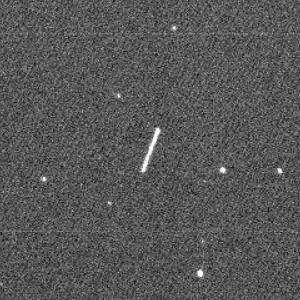
2022 EB5 on its way to Earth, observed by Krisztián Sárneczky, a Hungarian astronomer who was first to spot the asteroid. Image by Krisztián Sárneczky.
Saving humans from deadly space rocks
Scientists are studying how nuclear weapons could divert or annihilate threatening space rocks. And later this year, the Double Asteroid Redirection Test, a NASA space mission, will slam into an asteroid in an attempt to change its orbit around the sun — a dry run for the day when we need to knock an asteroid out of Earth’s way for real.
But such efforts will mean nothing if we remain unaware of the locations of potentially hazardous asteroids. There are still far too many known unknowns. Although scientists suspect that most near-Earth asteroids big enough to cause worldwide devastation have been identified, a handful may still be hiding behind the sun.
More concerning are near-Earth asteroids about 460 feet across, which number in the tens of thousands. They can create city-flattening blasts “larger than any nuclear test that’s ever been conducted,” said Megan Bruck Syal, a planetary defense researcher at the Lawrence Livermore National Laboratory. And astronomers estimate that they have currently found about half of them.
Even an asteroid just 160 feet across hitting Earth is “still a really bad day,” Bruck Syal said. One such rock exploded over Siberia in 1908, flattening 800 square miles of forest. “That’s still 1,000 times more energy than the Hiroshima explosion.” And perhaps only 9 percent of near-Earth objects in this size range have been spotted.

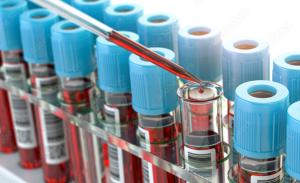
Test tubes containing blood samples. New research using decades-old astronaut blood samples reveals potential biomarkers for space flight health risks.
Old blood reveals new data
A new study using blood samples taken from astronauts before and after various space shuttle missions from 1998 to 2001 revealed potential biomarkers, which could be used to predict the health risks posed by space travel.
An international group of researchers including Lawrence Livermore scientists detail how they analyzed exosomes, vesicles which transmit information between cells, isolated from the blood plasma of three astronauts.
It turns out that you can use the old samples and get very important information about the effects of spaceflight. The team looked for different types of RNA in the exosomes they isolated. Like DNA, RNA is a molecule found within living cells. While DNA stores our genetic information, RNA plays a role in gene expression.
For this study, the researchers focused on long non-coding RNA, which plays a role in regulating how our behaviors and environments affect our genes. They found approximately 27 long non-coding RNAs change in their expression after coming back from spaceflight.

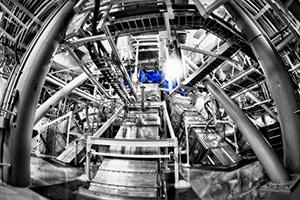
Beamlines entering the lower hemisphere of the National Ignition Facility (NIF) target chamber. NIF is the most energetic laser in the world.
Doubling down on fusion
The White House held a summit last week on fusion, which could someday become a major source of carbon-free energy. Fusion is made by pressing atoms together to create heavier ones. Nuclear fusion is the energy process that powers stars, with a low radiation and tremendous energy output.
The Biden administration, and a growing cadre of risk-taking investors, see fusion as an important tool on the path to an economy with net-zero greenhouse gas emissions by 2050.
Lawrence Livermore Director Kim Budil sat on a summit panel of experts discussing the advantages of fusion power.
The Department of Energy will coordinate all of its fusion energy research to advance the technology for “possible” deployment by the end of the decade, Energy Secretary Jennifer Granholm said. The latest $1.5 trillion appropriations bill from Congress included $45 million for a new fusion program in which private companies will partner with DOE to build new fusion energy devices. It’s part of a record investment in fusion that will send more than $700 million to DOE’s Fusion Energy Sciences program.

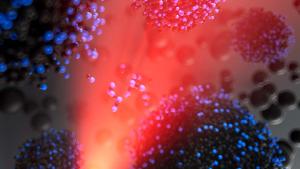
Artist’s interpretation of reactive transport between liquid nanocarbon clusters predicted to form from shock compressed cryogenic liquid carbon monoxide. Small black and blue beads correspond to carbon and oxygen atoms respectively, and the red light is meant to evoke the laser used drive shock compression experiments. Image by Brendan Thompson/LLNL.
Tailor made
Carbon exhibits a remarkable tendency to form nanomaterials with unusual physical and chemical properties, arising from its ability to engage in different bonding states. Many of these “next-generation” nanomaterials, which include nanodiamonds, nanographite, amorphous nanocarbon and nano-onions, are currently being studied for possible applications spanning quantum computing to bio-imaging.
Ongoing research suggests that high-pressure synthesis using carbon-rich organic precursors could lead to the discovery and possibly the tailored design of many more.
To better understand how carbon nanomaterials could be tailor-made and how their formation impacts shock phenomena such as detonation, Lawrence Livermore scientists conducted machine-learning-driven atomistic simulations to provide insight into the fundamental processes controlling the formation of nanocarbon materials, which could serve as a design tool, help guide experimental efforts and enable more accurate energetic materials modeling.

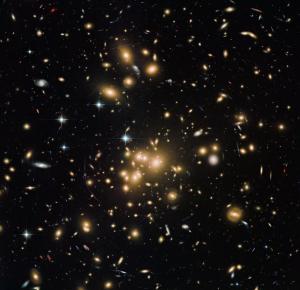
This Hubble image shows galaxy cluster Abell 1689. It combines both visible and infrared data from Hubble’s Advanced Camera for Surveys (ACS) with a combined exposure time of over 34 hours to reveal this patch of sky in greater and more striking detail than in previous observations. Image credit: NASA, ESA, the Hubble Heritage Team (STScI/AURA), J. Blakeslee (NRC Herzberg Astrophysics Program, Dominion Astrophysical Observatory), and H. Ford (JHU).
You are not alone
Galaxies rarely live alone. Instead, dozens to thousands are drawn together by gravity, forming vast clusters that are the largest objects in the universe.
Scientists have long known that the hydrogen gas in galaxy clusters is searingly hot — about 10 million degrees Kelvin, or roughly the same temperature as the center of the sun — which is so hot that hydrogen atoms cannot exist. Instead, the gas is a plasma consisting of protons and electrons.
There is no straightforward explanation for why or how the gas stays so hot. According to the normal rules of physics, it should have cooled within the age of the universe. But it hasn’t. The challenge for anyone trying to solve this puzzle is that you can’t exactly create these kinds of powerfully hot and magnetic conditions in your backyard.
However, there is now one place on Earth where you can: the most energetic laser facility in the world. The National Ignition Facility at Lawrence Livermore National Laboratory is able to create such extreme conditions — though only for a tiny fraction of a second in a volume the size of a dime.





